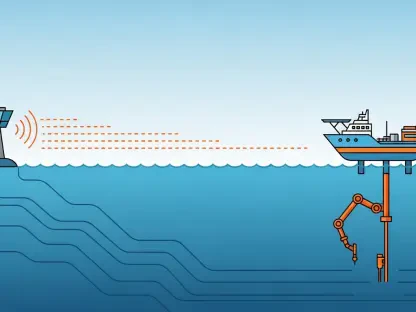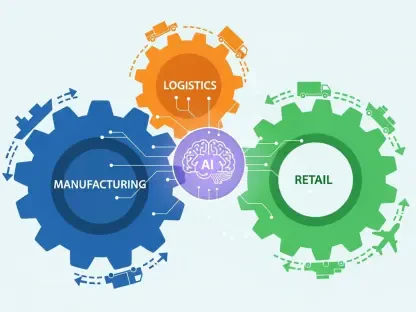In a remarkable stride forward for energy storage technology, researchers at the University of Chicago Pritzker School of Molecular Engineering have tapped into the power of artificial intelligence to identify high-performing battery electrolytes using an astonishingly small amount of initial data. This pioneering study, published in Nature Communications, showcases a transformative approach to materials discovery at a time when the demand for advanced batteries to support renewable energy and electric vehicles is more urgent than ever. Traditional methods, often spanning decades of meticulous lab work to gather comprehensive datasets, fall short in meeting today’s fast-paced innovation needs. Led by Assistant Professor Chibueze Amanchukwu, the team began with just 58 data points—a fraction of what is typically required for robust AI models—and focused on anode-free lithium metal batteries, known for their high energy density yet plagued by stability challenges. By employing an active learning model to sift through a virtual chemical space of one million potential solvents, this research not only accelerates discovery but also integrates real-world testing to ensure practical outcomes, setting a new benchmark for the field.
AI’s Role in Revolutionizing Battery Research
Tackling the Data Shortage
The foundation of this groundbreaking research lies in its ability to achieve significant results despite starting with a minimal dataset of only 58 data points, a stark contrast to the vast amounts of information usually needed for AI-driven models. This scarcity reflects the early stage of exploration into next-generation battery chemistries, where extensive experimental records are simply not yet available. The global push for sustainable energy solutions, however, demands rapid advancements that cannot wait for years of data accumulation. By leveraging an active learning approach, the model iteratively builds on this limited information, demonstrating that substantial progress is possible even under constrained conditions. This strategy highlights AI’s potential to navigate around traditional research bottlenecks, offering a lifeline for urgent technological needs in energy storage and beyond, where time is often the critical factor.
Moreover, the success with such a small initial dataset underscores a shift in how scientific discovery can be approached when resources are sparse. Instead of being hindered by the lack of comprehensive data, the active learning framework used by the team adapts dynamically, prioritizing which potential electrolytes to investigate based on predictive uncertainty. This method ensures that each step taken is informed by the most promising leads, maximizing efficiency in a field where trial and error has historically dominated. The implications extend far beyond batteries, suggesting that other areas of materials science facing similar data limitations could adopt comparable AI strategies to accelerate innovation. This adaptability marks a pivotal moment, proving that cutting-edge technology can thrive even when starting from the bare minimum, reshaping expectations for research timelines in high-stakes industries.
Expanding Beyond Human Limitations
One of the standout advantages of AI in this study is its capacity to transcend human biases that often constrain scientific exploration. Researchers, bound by familiarity, tend to focus on well-trodden chemical spaces where outcomes are somewhat predictable, potentially missing out on novel solutions. AI, as noted by co-first author Ritesh Kumar, operates without such predispositions, venturing into uncharted territories of the chemical landscape to propose electrolyte candidates that might otherwise be overlooked. This fearless exploration opens up new avenues for discovery, particularly in the context of anode-free lithium metal batteries, where innovative materials are desperately needed to overcome persistent stability issues. The result is a broader, more diverse pool of options that enriches the potential for breakthroughs in energy storage technology.
Furthermore, this unbiased approach by AI not only diversifies the scope of research but also challenges the conventional mindset within the scientific community. By identifying possibilities outside the typical focus areas, the technology encourages a rethinking of how materials are selected for testing, pushing boundaries that human intuition alone might not cross. In the case of this study, the identification of four high-performing electrolytes stands as a testament to the value of such exploration, showing that AI can uncover hidden gems in vast chemical spaces. This capability is particularly crucial for next-generation energy solutions, where the stakes are high, and the need for unconventional thinking is paramount. As a result, AI emerges as a powerful ally in driving progress, complementing human expertise with a fresh, impartial perspective that fuels innovation in unexpected ways.
Bridging Theory and Practice
Validating Predictions with Real-World Experiments
A defining feature of this research is the emphasis on grounding AI predictions in tangible, real-world outcomes rather than relying solely on computational simulations. As co-author Ritesh Kumar has pointed out, theoretical models can often produce results that don’t hold up under practical conditions, leading to misleading conclusions. To counter this, the team committed to physically constructing and testing batteries with the AI-suggested electrolytes, focusing on critical metrics like cycle life and discharge capacity. This hands-on validation ensures that the identified materials are not just promising in theory but are viable for actual application in energy storage systems. Such a rigorous approach sets this study apart, addressing a common gap in AI-driven research where practical relevance is sometimes sacrificed for computational convenience.
Additionally, the decision to prioritize experimental testing reflects a deeper understanding of the complexities involved in battery technology. Cycle life, in particular, serves as a cornerstone for evaluating electrolyte performance, as it directly impacts how long a battery can function effectively over repeated use. By integrating these real-world assessments into the research process, the team bridges the divide between abstract data and actionable results, offering a model for how AI can be applied responsibly in materials science. This commitment to validation not only enhances the credibility of the findings—culminating in the discovery of four top-tier electrolytes—but also provides a blueprint for future studies aiming to translate digital predictions into physical success. The focus on practicality ensures that advancements in battery technology are not just theoretical exercises but steps toward real-world solutions for sustainable energy.
Refining Results Through Iterative Processes
The active learning model employed in this study stands out for its iterative nature, which allows for continuous improvement of predictions over multiple cycles of testing and feedback. Over the course of seven distinct campaigns, with approximately 10 electrolytes evaluated in each, the AI system honed its suggestions by assessing uncertainty and prioritizing the most promising candidates for experimental validation. This cyclical process of prediction, testing, and refinement enabled the team to reduce errors and enhance accuracy, ultimately leading to the identification of four electrolytes that rival state-of-the-art options in performance metrics. The iterative approach exemplifies how AI can adapt and learn in real time, offering a dynamic solution to the challenges posed by limited initial data in cutting-edge research fields like battery development.
Beyond the immediate results, this iterative refinement process highlights the synergy between computational intelligence and experimental rigor, creating a feedback loop that drives consistent progress. Each campaign provided new insights that were fed back into the model, allowing it to better navigate the vast virtual space of one million potential solvents. This methodical progression not only mitigated the risks of spurious outcomes often associated with AI trained on small datasets but also built a robust framework for discovery that could be scaled to other materials science challenges. The success of identifying high-performing electrolytes through this method underscores the potential for active learning to transform research practices, ensuring that each step is informed by both data and reality. It’s a compelling demonstration of how technology and hands-on testing can collaborate to achieve reliable, impactful outcomes in the pursuit of advanced energy storage solutions.
Future Horizons for AI in Materials Science
Designing Novel Molecules with Generative Technology
Looking toward the next frontier, the research team envisions expanding AI’s role from merely selecting existing options to creating entirely new molecules through generative models. As suggested by co-first author Peiyuan Ma, such technology could tap into a chemical space of unimaginable scale, designing electrolytes and other materials that don’t yet exist in any database. This shift from predictive to creative AI represents a significant leap, potentially unlocking configurations that could revolutionize battery performance and other applications in materials science. The prospect of crafting bespoke solutions tailored to specific needs offers a tantalizing glimpse into how far this technology could push the boundaries of innovation, addressing challenges in energy storage with unprecedented originality and precision.
Additionally, the move toward generative AI signals a broader transformation in how scientific discovery might evolve over the coming years. Unlike traditional approaches constrained by pre-existing data, this method would allow for the exploration of theoretical possibilities previously unimaginable, creating materials from the ground up based on desired properties. For battery electrolytes, this could mean designing compounds that inherently balance high energy density with exceptional stability, tackling issues that current options struggle to resolve. While still in the conceptual stage for this team, the potential impact of such technology is profound, promising to redefine the pace and scope of advancements in sustainable energy solutions. It’s a bold vision that positions AI not just as a tool for analysis but as a creator of entirely new possibilities in the realm of materials science.
Evaluating for Commercial Viability with Broader Criteria
Another critical direction for future AI applications in this field involves assessing materials on a wider array of factors beyond just performance metrics like cycle life. Safety, cost, and base capacity are equally vital considerations for ensuring that newly discovered electrolytes can transition from lab to market. The team aims to develop models that incorporate these multi-criteria evaluations, providing a more holistic view of a material’s potential for commercial use. This comprehensive approach would help bridge the gap between experimental success and practical adoption, addressing real-world constraints that often hinder the deployment of cutting-edge technologies in industries reliant on energy storage, such as electric vehicles and renewable energy grids.
Furthermore, integrating these diverse evaluation parameters into AI models could significantly enhance the relevance of research outcomes for stakeholders across the energy sector. By simulating how an electrolyte might perform under varied conditions—factoring in economic feasibility alongside technical prowess—such models would offer a clearer path to scalability and implementation. This focus on commercial viability ensures that innovations don’t remain confined to academic curiosity but instead contribute directly to solving pressing global challenges. The vision of balancing multiple criteria through AI-driven analysis represents a forward-thinking step, aligning scientific discovery with the practical demands of modern energy needs. It’s an ambitious yet necessary evolution, poised to make AI an indispensable partner in creating materials that are not only groundbreaking but also ready for widespread application.
Reflecting on a Milestone in Energy Innovation
Reflecting on this landmark study, it’s evident that the integration of AI with experimental validation marked a turning point in the quest for advanced battery electrolytes. The achievement of identifying four exceptional candidates from a starting point of just 58 data points demonstrated the immense potential of active learning to overcome traditional research constraints. The commitment to real-world testing alongside computational predictions ensured that the results held practical value, setting a high standard for future endeavors. As the field looked ahead, the exploration of generative AI and multi-criteria assessments emerged as exciting next steps, promising to further refine how materials are discovered and applied. This research laid a robust foundation, inspiring confidence that technology could continue to drive sustainable energy solutions through innovative, data-efficient methods.









